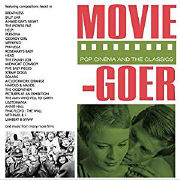- HOME
- SHOPPING
- Pre-Order (Upcoming)
- Pre-Order Imported
- Pre-Order Japanese
- New Releases
- New Imported
- New JPN Movie & TV
- New JPN Anime
- New JPN Game
- New Blu-ray/DVD/etc.
- Imported CDs
- Japanese Releases
- Japanese Movie & TV
- Foreign Movie & TV
- Anime
- Game
- Blu-ray/DVD/etc.
- Shopping Cart
- SPECIAL
- Feature Articles
- On Sale
- INFORMATION
- About Us
- Service Center
- News & Information
- Contact Us
- Mail News
- Japanese Site
- Close MENU
- HOME
- MOVIE-GORE: POP-CINEMA & THE CLASSICS

Although by the mid '60s the use of pre-existing classical music in films had already been deployed with sensitivity and humour by such directors as Alexander Mackendrick, Jean-Luc Godard, Pier-Paolo Pasolini, Glauber Rocha, Richard Lester, Ken Russell and Ingmar Bergman, Stanley Kubrick was the first to give it a central role in an entire film. 2001: A Space Odyssey and A Clockwork Orange used swathes of Also Sprach Zarahustra, The Blue Danube Waltz, Ligeti's Lux Aeterna and Beethoven's Ninth Symphony to famous dramatic effect, with Kubrick explaining, "Unless you want a pop score, I don't see any reason not to avail yourself of the great orchestral music of the past and present". Coming into vogue after Kubrick, the system offered the director flexibility and control. It was a valid, stylish way of clarifying the underlying emotion of a scene or establish mood; a way to compliment the film narratively, theatrically, structurally and conceptually. Instrumental classical works or traditional song are featured in A Hard Day's Night, Help!, Privilege, Head, The Man Who Fell to Earth, Lisztomania and Absolute Beginners, and all say something of pop's relationship with the classics. Bowie actually performed the Holst piece live in 1966. Modest Mussorgsky's Pictures at an Exhibition was the subject of an adaptation by Emerson Lake and Palmer and was showcased in a fascinating live performance film of the group shot at the Lyceum Ballroom in 1970 (though the film was not given a cinematic release until 1973). ELP's contemporaries, Yes, drew inspiration from Igor Stravinsky and paid homage by using the final movement from The Firebird as introductory music at their concerts from 1972 and for decades on. During The Beatles' Help! Paul McCartney is miniaturised to the strains of Wagner, while in a dank Chiswick pub cellar, the singing of Beethoven's Ode to Joy saves Ringo from an escaped tiger. In Hal Ashby's black comedy Harold & Maude, Harold is obsessed by death, and likes to stage elaborate fake suicides to get the attention of his distracted mother, including an attempted drowning to Tchaikovsky's Piano Concerto No. 1. During The Godfather, the baptism sequence, interspersed with scenes of the brutal assassinations of the heads of the five families opposing the Corleones is underscored by the intensity of Bach's organ work Passacaglia in C Minor. On a lighter, note, Michael Caine's Harry Palmer during the Ipcress File chooses Mozart to cook by, a musical enthusiasm shared by Jean Seberg, immortalised by Godard in Breathless. These are but a few of the indelible scenes complemented by the classical music featured in this presentation.
Track ListRelease Date: 2019/7/5
- Disc 1 -
1 Breathless (A Bout de Souffle) (1960)-Clarinet Concerto K 622 - Rondo Allegro - W.A. Mozart
2 Billy Liar (1963)-Song of the Clyde - Kenneth McKellar
3 Concerto Symphonique No. 4, Op. 102 - Henry Litolff
4 A Hard Day's Night (1964)